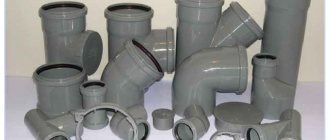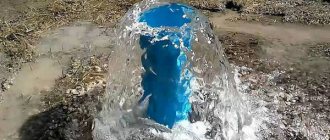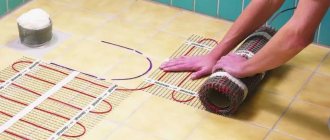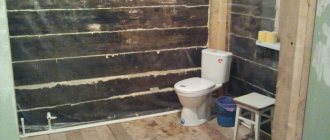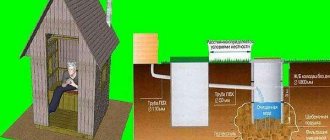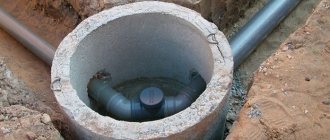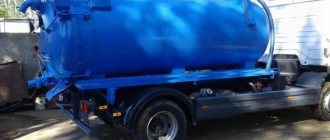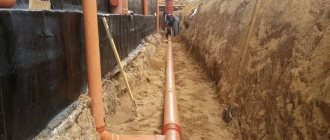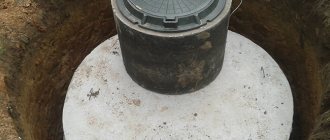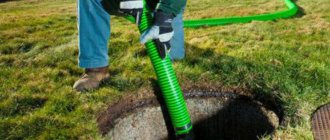Such materials will help to correctly install plumbing products, calculate the correct slope of pipes and make an estimate of the materials needed for the work.
The system created according to the drawings will work without breakdowns, and if a blockage occurs, it can be quickly eliminated.
The article was written specifically for those involved in the construction and installation of sewerage systems. Builders will be able, based on the text below, to draw up a sewer laying diagram for an individual house. Examples of calculations of external and internal sewer pipe installation systems are given.
Craftsmen will be able to calculate to what depth to bury the sewer pipe. It will be possible to calculate the necessary consumables for the installation of an autonomous sewer system, laid independently both indoors and around the house.
Internal circuit
The development of the scheme should begin with the most distant plumbing fixture installed on the top floor. The horizontal lines drawn must necessarily come to the riser. To save materials for work, plumbing fixtures are placed on different floors, but maintaining the same vertical.
The home sewer system includes:
- A water seal that protects the room from unpleasant odors;
- Pipes through which wastewater enters the external system;
- Knees;
- Tees;
- Clamps that support pipes and create a certain slope;
- Central riser
When installing a sewer system, it is very important to monitor the transition of pipes. It should not move from a larger diameter to a smaller one. To take this nuance into account, you need to install the toilet on the layout at the closest distance from the riser.
The drawing of the internal system includes several very important parameters:
- Number of floors;
- Basement;
- Number of plumbing fixtures;
- Number of apartments.
The diagram must be drawn to a certain scale. This will help you quickly understand the pipe layout when you need to identify problems in the event of an emergency.
How wastewater is filtered
When wastewater enters the sewer, it goes through the following filtration stages:
- First, the wastewater that enters the septic structure must settle in the first compartment. It is equipped with a special membrane protection, its task is to prevent foam and gases from entering;
- Having been purified, the liquid, under the pressure of the effluents following the first ones, moves into the next compartment, where impurities will be broken down under the influence of special means. After reacting with chemicals, impurities turn into suspensions;
- The suspension in the final compartment of the septic tank will precipitate, and the resulting liquid, after cleaning, passes into the distribution tank, from which it flows into the drainage channels.
The minimum distance from clean water sources should be strictly observed.
Anaerobic bacteria play a special role in the wastewater treatment process. They get inside the septic tank when special chemicals are used and help ensure a good level of purification. These bacteria also perform another function - protective; with their help, the system is not in danger of silting.
But a septic tank is not always able to completely break down all the impurities - in this case, they remain inside and, gradually accumulating, reduce the efficiency of operation. To clean the septic tank as it becomes dirty, you should equip it with a special hatch, through which, using a sewage disposal machine, the remaining impurities that settle inside will be removed.
You need to make sure in advance that the vacuum trucks can easily approach the septic tank to clean it. To do this, before installing the septic tank and drainage system, it is necessary to draw up a plan that will indicate the location of the septic tank and possible access routes.
To ensure the septic tank has the possibility of uninterrupted service, it is necessary to minimize the penetration of harmful and toxic impurities and insoluble additives into it. They may not have the best effect on the operation of the septic tank and significantly reduce its service life.
I hope that the material presented in this article helped answer your question about how to properly make drainage for a septic tank. Happy construction!
External line
To install a sewer system for an individual house, it is necessary to draw a diagram taking into account the surrounding landscape. Professionals recommend placing the septic tank as low as possible, and the pipes should have a slight slope.
To determine which treatment system needs to be taken as a basis and at what depth the pipes will lie, you need to pay attention to the following factors:
- Groundwater;
- Type of soil;
- Freezing depth.
The construction of external sewerage usually begins with laying a pipeline from the foundation. Drains should be discharged towards the constructed cesspool. Any turn of the pipe must be equipped with a special revision, in the form of an adapter equipped with a lid. Through it you can easily remove the blockage.
An inspection well is mounted on the outside and a ventilation hood is installed.
The ventilation pipes exit through a riser with an installed drain pipe. Since it will always have a very strong unpleasant odor, such a pipe should be installed as far as possible from the windows or next to the smoker.
It is prohibited to combine the fan pipe with an ordinary ventilation shaft. The umbrella can be replaced with a special vacuum valve installed at the top of the riser.
Remember that it has nothing to do with the check valve.
Briefly about the possible options
The procedure for installing a septic tank cannot be declared unambiguously, citing the same numbers. It's all about the variety that devices of this type have acquired. Some of them don’t even require decoration, because they already look aesthetically pleasing from the very beginning, and the photos of the products posted by the manufacturer clearly demonstrate this.
However, you need to decorate a banal drainage pit not only with a closing lid, but also, if possible, with moisture-loving plants. Nowadays such structures are not in fashion, although they used to be quite common. They were buried as they filled.
Waste filtration
The production of storage septic tanks solved the problem of the penetration of toxic or contaminated water into the soil, with the return of harmful substances in the form of grown vegetables and fruits, pollution of water bodies or groundwater.
A sealed septic tank for waste accumulation has a number of negative qualities - a capacity that is insufficient for permanent residence, and the need for periodic emptying.
The Topas storage system has many advantages, but is considered a good option only for seasonal living of a small family.
Incision
A cleaning septic tank on site can only solve 60% of the pollution problem. In addition, it requires the installation of several chambers, suitable soil and preferably a separate area where the resulting product will be released from the waste. But these waters are not even suitable for technical use, so the choice of such structures is treated with great caution, and the documentation for them is meticulously studied by the sanitary inspection.
If price is not a fundamental factor for a person who intends to live in a house for decades, it makes sense to build a high-tech septic tank, namely a local treatment plant. The operation of such a structure and installation can be seen in the video below.
This is a Eurobion local treatment station that will look inconspicuous. There are no obstacles to making it the main system, even if the number of acres of territory is limited. Moreover, the design provides for the possibility of doing it yourself. It is enough just to monitor the condition in time, use a drain pump and clean the compressor air filter.
Types of tanks, their positive and negative sides
The final part of the system is the tank where cleaning is carried out. If there is no central collector through which the drains are collected, then autonomous installations are used.
cesspool
This is perhaps the cheapest option. It is easy to dig a hole in the right place. However, it cannot always cope with large volumes of wastewater. Dirt can become a source of unpleasant odors in groundwater.
Septic tank
This structure can be made of brick and filled with concrete. You can also install standard reinforced concrete rings. If the septic tank is well made, it can be used for many years, as it is highly durable. The disadvantage of this design is long installation and large financial investments.
Self-contained installation, industrial type
Of course, such a design always costs much more, but all costs are fully covered thanks to the fast construction and very high quality. Such installations will work for a very long time with virtually no breakdowns.
Biological treatment system
We can safely say about such a system “the most expensive”. For its operation it is necessary to supply constant electrical power. However, it has high productivity and high-quality cleaning.
Why choose Septic Topas Plus products
Many companies offer the sale of equipment and installation of local sewage systems, and the company Septic Topas Plus is successfully engaged in this in the Moscow and Moscow region markets. We offer our clients exclusively high-quality waste disposal units - the best-selling and best models Topas, Unilos Astra, Eurolos, Termit, Tver, Diamant, Ergobox, Dochista, Terra, Biozon and Kolovesi. Each septic tank comes with a 3-year warranty, all devices are certified, and their price fully corresponds to the quality. A flexible system of discounts has been developed for regular customers, and there is an affiliate program.
How to choose a location for a wastewater receiver, how to calculate its parameters
Whatever the type of receiver, its volume must correspond to the three daily norms consumed by all residents of the house.
According to established standards, one person consumes 200 liters per day. Therefore, the volume of the receiver should be 600 liters. If the treatment plant has several connected tanks, the total volume will be equal to their sum.
The choice of receiver location depends on several requirements.
The standards also establish distances to particularly important objects; they must comply with accepted standards:
- 50 meters – to the drinking water pipe;
- 5 meters – to the road;
- 30 meters – to the reservoir;
- 5 meters - to the living space.
At what depth should sewer pipes be laid?
Technological standards (SNiP) establish a certain depth of sewerage in a private house.
To more accurately determine this value, you need to familiarize yourself with the zone map.
It shows the depth of soil freezing in various areas of our country. For example, in Moscow, the depth of laying a sewer pipe should be at least 1.4 m. For Sochi, this value is much less - 0.8 meters.
These parameters are taken taking into account the terrain when the soil freezes. If pipes are installed with a cross-section of less than 500 mm than indicated on the map, it is necessary to subtract 0.3 meters from this value. When it is necessary to lay large-diameter sewer pipes, the laying depth should be reduced by 0.5 meters.
Septic tank outlet pipe
The removal of treated wastewater from a septic tank occurs in 2 ways, of course, some craftsmen also have a 3rd method - through the lid, but we will look at the correct methods:
- gravity overflow from a septic tank into a drainage well
- forced drainage of water by a forced pump to the ground
With gravity, almost everything is done in the same way as with the supply pipe, slopes and angles can be made 90 degrees, since the outlet is process water and it is easier for it to run through the pipe with any angles, but with the correct slope. Insulation is also not necessary, but it will never be superfluous.
Forced removal of treated wastewater is carried out through a small diameter pipe (25-32 mm). The pipe material can be low-density polyethylene, polypropylene.
At a short distance of up to 2-3 m, you can make a counter-slope of the pipe so that after the pump has pumped out the water, the remaining water flows back into the septic tank. In this case, it is possible to insulate only with pipe insulation (energoflex, tilit).
If the distance of the outlet pipe from the septic tank to the drain point is large or you doubt whether the counter-slope will be observed, it is best to lay a heating cable and turn it on at sub-zero temperatures. Our recommendation is to install a heating cable for any length of the outlet pipe, and it is better not to turn it on if not required, but turn it on if necessary, if any arises.
One of the conditions for the proper operation of an autonomous sewer system is pumping out the septic tank. For this purpose, owners of private plots periodically use the services of vacuum cleaners who, using a special machine, remove liquid household waste. If it is not possible to provide convenient access for the vehicle to the treatment plant, an additional pipe is installed for pumping out from the septic tank, which allows dirty water to be collected from a considerable distance.
At what depth is the sewer pipe laid near the house?
Standardized standards indicate that the pipe leaving the room must be positioned so that it rises above the average freezing depth by approximately 30 cm.
The depth of the trenches should exceed 70 cm. For the middle zone, the minimum depth of the sewerage should reach 50 cm. This is quite enough if there is no area nearby that needs to be cleared of snow and there is no roadway.
It is very important to comply with the last requirements described above. The fact is that the pressure of the machines can lead to pipeline breakdown, and if there is a large accumulation of snow, the pipe will simply freeze.
To create gravity flow of sewage drains, you need to know exactly what slope needs to be created for the sewer pipe, especially in a private building.
In principle, you can ask your neighbors. They know well what trench depth is needed. They have already laid such pipes and tested the system. Therefore, their data will be the most optimal, especially for winter.
If you have any doubts or difficulties when carrying out such plumbing work, you should contact a professional. Such companies employ highly qualified specialists with extensive experience and appropriate tools. If you do not have the skills for such work, then independent operations can lead to damage to the material and additional financial costs.
Bookmark depth and optimal tilt amount
For pipes with a diameter of up to 50 mm, SNiP recommends making the slope equal to 3 cm per one meter of installation.
If the pipe cross-section reaches 100 mm, then the slope can be reduced by one centimeter. To prevent the sewer system from becoming clogged and possible “greasing” to occur, it is advisable to increase the slope by about half a centimeter for each meter of wiring.
The same angle of inclination is maintained when laying pipes in the area near the house. A sleeve is installed in the foundation. Its diameter is 15 cm larger than the main pipe. Thanks to the sleeve, a transition to the external sewer occurs. It is mounted above the freezing level of the soil by 30 cm.
Then a trench is dug to provide access to the septic tank. Its approximate depth should be no more than one meter.
Do not bury sewer pipes below the existing freezing level. Its average value does not exceed 1.6 m. Such work will be very unprofitable, since it will be necessary to make the septic tank deeper. If a constant slope of approximately 4–5 m is maintained, groundwater may appear.
Such work requires additional financial investments, since it is necessary to install additional concrete rings and special high-strength corrugated pipes. They withstand the pressure of the drain perfectly, they do not deform with a large mass of soil.
The normal temperature of the drain is always higher than in the room, so the pipes do not freeze. Sometimes they are insulated with thermal insulation or a heating cable is laid.
Principles of sewer pipeline construction
Principles of sewer pipeline construction
If you decide to install a septic tank and a pipeline to it from the house, then SNiP provides the basic rules for creating a high-quality and efficient wastewater disposal system.
- Thus, it is recommended to install the collector solely based on the previously drawn up design documentation. At the same time, when creating a project, it is very important to take into account all the communications available on the site, such as water supply, electricity, etc., located in the ground.
- It is necessary to draw up a sewerage project for the site taking into account a possible increase in the load on the collector in the future.
Important: according to SNiP, the ideal sewerage project is considered to be one that requires a minimum investment and at the same time allows you to create an effective working system.
Method for calculating the depth of a pipe connected to a storage tank
The size of the pipe outlet in the room increases by the length of the external line, multiplied by a coefficient, the value of which is selected according to the diameter of the pipe:
- D 50 mm – 0.03;
- D 110 mm – 0.02;
- D 160 mm – 0.008;
- D 200 mm – 0.007;
The calculation is carried out according to the formula:
h2=h1+l*k+g,
h2 – depth of the point from where the exit and connection to the storage tank is made;
h1 – the value of the exit from the room. Take 1.4 m;
l – distance from the foundation to the storage well. Usually 10 meters.
k is the slope coefficient of the sewer pipe, always equal to 0.02;
g – natural slope of the surface. Usually does not exceed 0.3 m.
h2=1.4+10*0.02+0.3=1.9 m.
According to the calculation data, a sewer trench is created.
Diameter of external sewerage
The external main connects the outlet of the internal riser to the treatment facility. In this case, the diameter of the sewer depends on factors:
- presence of other pipelines on the site
- relief, groundwater level
For a gravity line of one cottage, 110 mm is enough; for a townhouse or cottage community, the cross-section of the pipeline will need to be increased to 150 mm. The slope in the first case is regulated by 3˚, in the second 2˚. In critical places (branches, long straight sections, changes in pipeline height), 300–1500 mm wells are installed through which sewerage maintenance is carried out. Individual developers give preference to the following designs:
- prefabricated serviced well 1.5 m in diameter, consisting of a neck, shaft, tray
- prefabricated maintenance-free well from a tray, corrugated pipes 600 – 300 mm
The diameter of the vacuum, pressure sewer can be reduced to 50 mm, since the power of injection pumps and vacuum compressors is sufficient for uninterrupted transportation of wastewater through a small cross-section of the pipeline.
The storm drain line is most often assembled from a solid
corrugated pipe Ø110 mm; a perforated analogue is used in the drainage line.
Wells are similar to outdoor system designs, and maintenance-free structures are most often used. Despite the name, they allow you to clear drains from the ground without going down the mine. A hose from a high-pressure washer is inserted into the pipeline , and the clogged area is washed with cold/hot water under high pressure. Corrugated pipes have their own fittings, and smooth modifications can be used. It is desirable to have pipes and fittings of the same material inside one main; this will significantly increase the service life of the system.
What problems may arise when installing a sewage disposal system, and how to solve them
In some cases, the depth of sewer installation during installation in a cottage depends on some external factors.
It happens that installation is simply impossible, or it requires huge financial costs. One of the reasons is considered to be rock located between the house and the well. In such a situation, it is impossible to make a standard trench, since the soil has a very complex structure.
The only way out of this situation is to insulate the pipes. Before you start installing the structure, you must wrap the pipeline with several thick layers of insulation, and then lay it to a depth of no more than 30 cm. It will be possible to create heating for the pipe, for which you will need to lay a heating cable under the pipe.
How to set up a filter field
The parameters for arranging a filtration field should be determined depending on the type of soil and how suitable it is for self-purification. The sequence of arranging the filtration field for a septic tank will be as follows:
- Dig a trench and pour a layer of purified sand onto its bottom. The layer thickness should be approximately 10 cm.
- A layer of crushed stone with a fraction of 20-40 mm should be poured on top of the sand cushion. The crushed stone layer should be about 35 cm thick.
- Now a drain is laid on the crushed stone layer and again covered with crushed stone on top. Geotextiles are laid on top of a layer of crushed stone 10 cm thick - this will protect the system from silting.
- After this, the trench is covered with a layer of soil.
Filtration field in a drainage system for a septic tank
